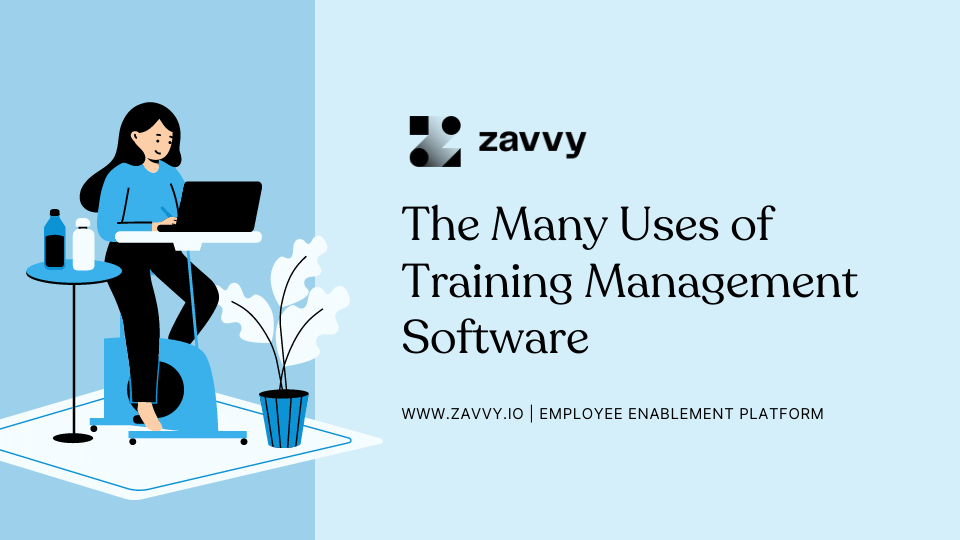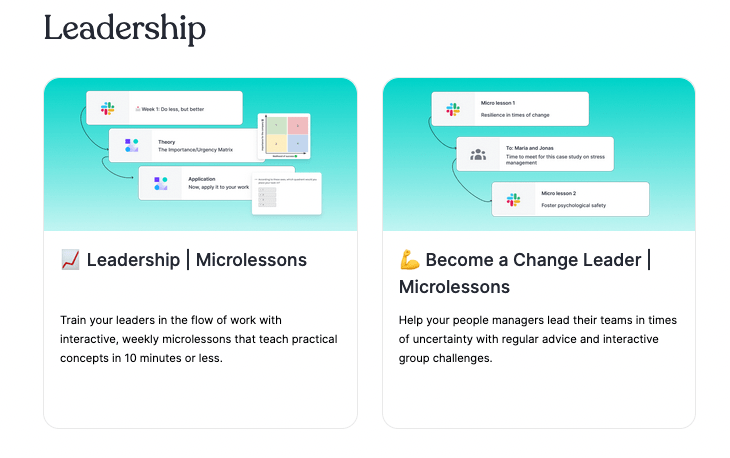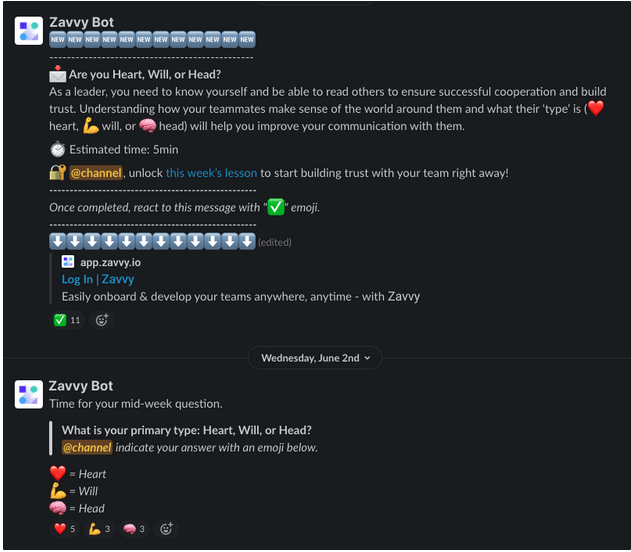
Keke Kaikhosroshvili
Keke is Zavvy's expert in learning experience. On our blog, she shares experience and insights based on her studies in learning design and experiences made with our customers.


Is your organization stuck in the past when it comes to training management?
Perhaps you rely on spreadsheets and email chains to keep track of course deliveries, online learning strategies, and other essential training admin.
If so, don't despair — this is how most organizations have managed their training at one point or another.
But time and technology have both moved on, so why not step out of the dark ages and take advantage of cutting-edge training management systems to transform your workforce?
"The responsibility of learning has always been to help organizations navigate uncertainty and chaos in the world." Linda Cai, Vice President Talent Development, LinkedIn.
Together with our curators, we have created a library of actionable digital marketing resources. Personalized to your team's needs.
A training management system, or TMS, streamlines your approach to training.
Instead of having course materials and admin tools scattered across a variety of paper-based or digital solutions, you'll organize everything from your single TMS hub.
It's more efficient, cost-effective, and less stressful than your previous approach.

The beauty of using a TMS is that it caters to organizations of all sizes and various industries.
A TMS will simplify the process whether you're creating content for your internal employees, business partners, or customers.
So, who will be logging in and making the most of the product?

The back end of your TMS allows your in-house L&D team to make essential admin changes. This might include:
Having opportunities to learn and grow is the top way to define an exceptional work environment, according to the Glint Employee Wellbeing report.
So, whether you're
Your training management software will be an essential and accessible course delivery method.
But there's no need to restrict your TMS to an internal audience.
Why not train your customer base on how to get the most out of your product?
Additionally, make your training available to business partners, so they come to the table with a greater understanding of what you're offering.
Use your TMS to complete all tasks related to training management.
Your software handles everything from collating and presenting your course materials to scheduling learning and tracking course progress. The latter can be handy for measuring training effectiveness.
You'll entice learners to your platform and then keep them engaged with fun and interactive training that fits in perfectly alongside their job and work-life balance.
TMS systems differ significantly in terms of functionality.
Tip: Be sure to pick user-friendly software at the back-end and front-end.
The following traditional components are at the heart of most training and learning management systems.
"Corporate learning design is slowly but surely morphing with UX, product development, content strategy, and marketing." Egle Vinauskaite, Learning Strategist, Skillbright Labs.
There's no "one-size-fits-all" when it comes to training management dashboards.
Some tech companies, including Zavvy, build significantly on the foundations of a traditional TMS, offering advanced features to support behavioral learning.

Incorporating just 5 minutes of learning each day into our routines has powerful results. And you can easily accomplish this with the following:
Tip: A software solution is accessible across various desktop and mobile devices and browsers.
Tip: The best way to continuously encourage learners to engage with your training platform is to send push notifications wherever they're already hanging out during the working day. Often, this means connecting Slack or Teams to your TMS.
Tip: Accountability partners strengthen motivation. Plus, learners create more neural connections as they engage in collaborative training sessions.
Training management software solves some of the following problems:

Isn't it about time you analyze the productivity of your learning and development teams?
Asana's Anatomy of Work Global Index report of 2022 highlights that employees are consistently bogged down in "work about work."
Specifically, businesses lose 23 hours of a 40-hour workweek to menial, repetitive tasks such as communicating about work, searching for information, switching between apps, and chasing status updates.
If this sounds familiar, a training management system will improve productivity by winning back valuable hours for your organization.
Staff salaries are among the highest costs associated with training programs, whether you host instructor-led training in a classroom or as part of an e-learning setup.
Switching to a TMS system can reduce the costs of hiring trainers for synchronous courses. But you'll also save money on the admin hours required to run your program.
What does your current training tech stack look like? Perhaps you have an assortment, including:
Maybe you host a Notion board with links to some of these different solutions? That might make it easier for the end-user, but a TMS would simplify management for your admin team.
A lack of data about training progress can impact the learning experience for your employees. For example, you might send round-robin emails to your entire workforce, encouraging them to engage in your training program. But this communication would be a nuisance for those already participating.
Instead, an automated training management system will track course completion and the progress of compliance courses for every program. This efficient approach makes it easy to measure participation in just a few seconds.
We're all aware of the fallout of the Great Resignation: 47 million Americans alone quit their jobs in 2021.
But what fewer people understand is the glaring link between skills training and employee retention.
The average retention span of a company employee is just 2.9 years in 2022. But for those organizations that prioritize on-the-job learning, this increases to an average of 5.4 years.
Let your TMS help you do just that!
So, what do TMS systems look like in action? Here are five examples used in corporate training and higher education.
Zavvy's training and learning management system allows companies to run their training programs on autopilot.
➡️ Explore our training templates gallery. You'll access real Zavvy journeys made by our learning designers, customers, and other forward-thinking companies.

Loved by companies such as Freeletics and Primer, Zavvy's platform will enable you to launch a course in minutes. You will assign it to the right people at the right time and track progress at the click of a button.

➡️ Read more about how Zavvy helped Freeletics create a training routine for their leaders.
Menopause Mentors is a CPD Certified course developed by Over The Bloody Moon. It's an engaging TMS available to companies who want to raise awareness and support employees impacted by menopause. Plus, the program includes the capability for virtual sessions where menopause mentors can share learnings and insights.

Although it's not a perfect fit for corporate training, Its Learning houses a vast content library useful for creating courses aimed at the K-12 and higher education market. The TMS also has analytics and advanced reporting embedded, along with the ability to handle group projects when students need to work as a team.
If you need a training management system for healthcare workers, then EthosCE is a good shout. The platform targets medical associations, medical education companies, academic medical centers, and more. It boasts an intuitive user interface and excellent course productivity rates.
Sakai is a free and open-source course builder aimed at the tutoring niche. Users can create their training programs. You can use modules to store text, quizzes, videos, and more.
The platform also allows easy collaboration between teachers and their students, for example, receiving feedback on assignments.
Is your organization ready to reap the benefits of a training management system?
72% of leaders believe L&D has become a more strategic function, so this area is worth prioritizing to progress your business.
If your current approach to learning is haphazard at best, try a more streamlined approach to your e-learning content.
From creating compelling spaced learning content to integrating with your existing communication channels, Zavvy's cloud-based learning management platform is a cut above the rest.
Get in touch today to arrange a demo and consultation with our team.
Still got questions about how to use a TMS? We've got you covered!
A training management system can form part of your online training strategy. But online training doesn't always use a TMS.
Let's look at this a little closer. Suppose you run virtual instructor-led online courses via Zoom or similar that require learners to train in real-time. Such a course is online training but doesn't use a training management system. And it's quite different from receiving bite-sized chunks of training materials through a learning management platform.
There's a significant cost-saving benefit to training asynchronously, rather than with a live instructor, as you don't need to pay the trainer to run each separate course delivery.
Training can also be intense and more long-winded in lengthy course modules, making it harder for the brain to retain the new information.
Instead, spaced learning delivered via a training management system increases knowledge retention.
Technology moves so fast that organizations don't believe they have the time or resources to keep up.
When business leaders stay entrenched in their traditional employee training methods, committing to digital training strategies might be challenging.
But the truth is that if you want your business to progress and stay relevant, switching to digital is a must-do.
"There's an opportunity to pilot more varied L&D activities and tools: personalized learning content using recommender systems, push content via chatbots, peer-based knowledge sharing on collaborative platforms, and the integration of curated external content with custom internal in-house content." Stella Lee, Director, Paradox Learning.
The good news is the training process doesn't have to be complicated. With the right training management system in place, you can easily make the transition.

Training management systems (TMS) and learning management systems (LMS) share many commonalities.
The main difference is how you're using the software.
Employees and customers using your platform to consume course content are accessing the learning management component of the system.
At the same time, anyone with admin rights to your tool is using it as a training management system as it encompasses your entire learning and development program.
Tracking course progress is just one (important) aspect of digital training management.
Tracking helps you understand how engaged your employees are in your learning platform.

Tip #1: If you have high uptake numbers but low course completion, evaluate how to make your training content more engaging.
Tip #2: On the other hand, if you're struggling to get learners to get started in the first place, look at how to spread awareness of your training systems through push notifications and similar.
Tip #3: Tracking also shows leaders which employees have completed the training and which parts they struggled with. This data allows you to adapt the course content accordingly, refocusing on the most critical topics.
Tip #4: Experiment with interactive features like gamification depending on their popularity. If you know that your quizzes are a hit, include more of them!
Upskill your team every week with the best contents and personalized recommendations.

Is your organization stuck in the past when it comes to training management?
Perhaps you rely on spreadsheets and email chains to keep track of course deliveries, online learning strategies, and other essential training admin.
If so, don't despair — this is how most organizations have managed their training at one point or another.
But time and technology have both moved on, so why not step out of the dark ages and take advantage of cutting-edge training management systems to transform your workforce?
"The responsibility of learning has always been to help organizations navigate uncertainty and chaos in the world." Linda Cai, Vice President Talent Development, LinkedIn.
Get a demo!
We'll be happy to show you around and answer all your questions.
Trusted by innovative companies



We'll be happy to show you around, answer your questions, or arrange a free trial.
Erhalten Sie eine kostenlose Demo unserer Onboarding-Software.
Vertraut von



Your Training & Development Strategy - Solved in 1 Tool.
Trusted by innovative companies



We'll be happy to show you around, answer your questions, or arrange a free trial.
Learn how Zavvy helps you drive performance, development, and engagement.
Trusted by innovative companies



We'll be happy to show you around, answer your questions, or arrange a free trial.
We'll be happy to show you around and answer all your questions.
Trusted by innovative companies



We'll be happy to show you around, answer your questions, or arrange a free trial.
Gerne zeigen wir Ihnen ganz unverbindlich unsere Plattform im Detail.
Vertraut von modernen Unternehmen



Get a demo!
We'll be happy to show you around and answer all your questions.
Trusted by innovative companies



We'll be happy to show you around, answer your questions, or arrange a free trial.
Erhalten Sie eine kostenlose Demo unserer Software für Mitarbeiterenwicklung und Training.
Moderne Unternehmen
setzen auf Zavvy


